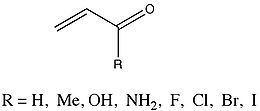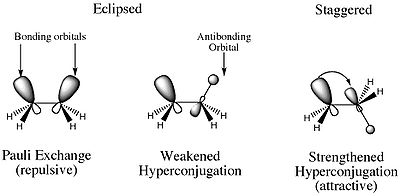- Hyperconjugation
-
In organic chemistry, hyperconjugation is the interaction of the electrons in a sigma bond (usually C–H or C–C) with an adjacent empty (or partially filled) non-bonding p-orbital or antibonding π orbital or filled π orbital, to give an extended molecular orbital that increases the stability of the system.[1][2] Only electrons in bonds that are β to the positively charged carbon can stabilize a carbocation by hyperconjugation.
Contents
History
The term was introduced in 1939 by Robert S. Mulliken[3] in the course of his work on UV spectroscopy of conjugated molecules. Mulliken observed that on adding alkyl groups to alkenes the spectra shifted to longer wavelengths. This bathochromic shift is well known in regular conjugated compounds such as butadiene. He was also the first to attribute the lower heat of hydrogenation for these substituted compounds (compared to those without substitution) to hyperconjugation. An effect predating the 1939 hyperconjugation concept is the Baker–Nathan effect reported in 1935.
Applications
Hyperconjugation can be used for rationalizing a variety of other chemical phenomena, including the anomeric effect, the gauche effect, the rotational barrier of ethane, the beta-silicon effect, the vibrational frequency of exocyclic carbonyl groups, and the relative stability of substituted carbocations and substituted carbon centred radicals. Hyperconjugation is proposed by quantum mechanical modeling to be the correct explanation for the preference of the staggered conformation rather than the old textbook notion of steric hindrance.[4][5]
Effect on chemical properties
Hyperconjugation affects several properties.[6][7]
- Bond length: Hyperconjugation is suggested as a key factor in shortening of sigma bonds (σ bonds). For example, the single C–C bonds in 1,3-butadiene and methylacetylene are approximately 1.46 angstrom in length, much less than the value of around 1.54 Å found in saturated hydrocarbons. This is due mainly to hyperconjugation that gives partial double-bond character of the bond.
- Dipole moments: The large increase in dipole moment of 1,1,1-trichloroethane as compared with chloroform can be attributed to hyperconjugated structures.
- The heat of formation of molecules with hyperconjugation are greater than sum of their bond energies and the heats of hydrogenation per double bond are less than the heat of hydrogenation of ethylene.
- Stability of carbocations:
-
- (CH3)3C+ > (CH3)2CH+ > (CH3)CH2+ > CH3+
- The C–C σ bond adjacent to the cation is free to rotate, and, as it does so, the three C–H σ bonds of the methyl group in turn undergoes the stabilization interaction. The more adjacent C-H bonds are the larger hyperconjugation stabilization is.
Hyperconjugation in unsaturated compounds
Early studies in hyperconjugation were performed by Kistiakowsky et al. Their work, first published in 1937, was intended as a preliminary progress report of thermochemical studies of energy changes during addition reactions of various unsaturated and cyclic compounds. This pioneering work would lead many to investigate the group’s puzzling findings.
Kistiakowsky and fellow researchers collected heats of hydrogenation data during gas-phase reactions of various species containing one double bond. When comparing the monosubstituted alkene compounds propylene, 1-butene, 1-heptene, isopropylethylene, t-butyl ethylene, and neopentylethylene they found that the respective methyl, ethyl, n-amyl, isopropyl, t-butyl, and neopentyl groups are equally effective in stabilizing the adjacent alkene. The overall range of the ΔH values for these compounds was only 0.8 kcal/mol.[8]






A portion of Kistiakowsky’s work involved a comparison of other unsaturated compounds in the form of CH2=CH(CH2)n-CH=CH2 (n=0,1,2). These experiments revealed an important result; when n=0, there is an effect of conjugation to the molecule where the ΔH value is lowered by 3.5 kcal. This is likened to the addition of two alkyl groups into ethylene. Kistiakowsky also investigated open chain systems, where the largest value of heat liberated was found to be during the addition to a molecule in the 1,4-position. Cyclic molecules proved to be the most problematic, as it was found that the strain of the molecule would have to be considered. The strain of five-membered rings increased with a decrease degree of unsaturation. This was a surprising result that was further investigated in later work with cyclic acid anhydrides and lactones. Cyclic molecules like benzene and its derivatives were also studied, as their behaviors were different from other unsaturated compounds.[8]
Despite the thoroughness of Kistiakowsky’s work, it was not complete and needed further evidence to back up his findings. His work was a crucial first step to the beginnings of the ideas of hyperconjugation and conjugation effects.
Stabilization of 1,3-butadiyne and 1,3-butadiene
The conjugation of 1,3-butadiene was first evaluated by Kistiakowsky, a conjugative contribution of 3.5 kcal/mol was found based on the energetic comparison of hydrogenation between conjugated species and unconjugated analogues.[8] Rogers et al., who used the method first applied by Kistiakowsky, reported that the conjugation stabilization of 1,3-butadiyne was zero, as the difference of ΔhydH between first and second hydrogenation was zero. The heats of hydrogenation (ΔhydH) were obtained by computational MP2 quantum chemistry method.[9]
Another group led by Houk et al.,[10] suggested the methods employed by Rogers and Kistiakowsky was inappropriate, because that comparisons of heats of hydrogenation evaluate not only conjugation effects but also other structural and electronic differences. They obtained -70.6 kcal/mol and -70.4 kcal/mol for the first and second hydrogenation respectively by ab initio calculation, which confirmed Rogers’ data. However, they interpreted the data differently by taking into account the hyperconjugation stabilization. To quantify hyperconjugation effect, they designed the following isodesmic reactions in 1-butyne and 1-butene.
Deleting the hyperconjugative interactions gives virtual states that have energies that are 4.9 and 2.4 kcal/mol higher than those of 1-butyne and 1-butene, respectively. Employment these virtual states results in a 9.6 kcal/mol conjugative stabilization for 1,3-butadiyne and 8.5 kcal/mol for 1,3-butadiene.
Trends in hyperconjugation
A relatively recent work (2006) by Fernández and Frenking (2006) summarized the trends in hyperconjugation among various groups of acyclic molecules, using energy decomposition analysis or EDA. Fernández and Frenking define this type of analysis as "...a method that uses only the pi orbitals of the interacting fragments in the geometry of the molecule for estimating pi interactions.[11]" For this type of analysis, the formation of bonds between various molecular moieties is a combination of three component terms. ΔEelstat represents what Fernández and Frenking call a molecule’s “quasiclassical electrostatic attractions.[11]” The second term, ΔEPauli, represents the molecule’s Pauli repulsion. ΔEorb, the third term, represents stabilizing interactions between orbitals, and is defined as the sum of ΔEpi and ΔEsigma. The total energy of interaction, ΔEint, is the result of the sum of the 3 terms.[11]
A group whose ΔEpi values were very thoroughly analyzed were a group of enones that varied in substituent.
Fernández and Frenking reported that the methyl, hydroxyl, and amino substituents resulted in a decrease in ΔEpi from the parent 2-propenal. Conversely, halide substituents of increasing atomic mass resulted in increasing ΔEpi. Because both the enone study and Hammett analysis study substituent effects (although in different species), Fernández and Frenking felt that comparing the two to investigate possible trends might yield significant insight into their own results. They observed a linear relationship between the ΔEpi values for the substituted enones and the corresponding Hammett constants. The slope of the graph was found to be -51.67, with a correlation coefficient of -0.97 and a standard deviation of 0.54.[11] Fernández and Frenking conclude from this data that ..."the electronic effects of the substituents R on pi conjugation in homo- and heteroconjugated systems is similar and thus appears to be rather independent of the nature of the conjugating system.".[11][12]
Hyperconjugation: Gronert vs. Schleyer
Gronert (see Gronert model) [13][14] proposed a 1,3 repulsive interaction, otherwise known as a geminal repulsion in place of hyperconjugation. This model explains differences in bond strengths based on differential steric strain relief as a result of bond cleavage. The key point of Gronert's model is that 1,3 repulsions are the major factor in determining stability of C–C of C–H bonds in alkanes. This broad overarching supposition is based on several already existing assumptions:
- The heats of formation of alkanes are determined only by 1,2 bonding interactions and 1,3 repulsive interactions.
- All C–H bonding interactions provide the same stabilization.
- All C–C bonding interactions provide the same stabilization.
- The 1,3 repulsive interactions can be grouped into C–C–C, C–C–H, and H–C–H interactions.
Gronert's work is a logical step from work done 50 years previous by Dunitz, Schomaker, Bauld, Wiberg, Bickelhaupt, Ziegler, and Schleyer. From the results of these groups, Gronert makes a leap of faith to assume that 1,3 repulsive interactions are not uniform and vary in magnitude based on what groups are involved.
Gronert's Method for Evaluating Alkane, Cycloalkane, Alkene and Alkyl radical heats of formation:
- ∆Hf = nC–CEC–C + nC=CEC=C + nC–HEC–H + nC–C–CEC–C–C + nC–C–HEC–C–H + nH–C–HEH–C–H – f(C,H)
where
- n = number of each type of interaction or atom
- E = stabilization/destabilization per interaction
- F(C,H) = (170.6 + EC)nC + 52.1nH
- EC = free parameter (correction term for electron pairing in atomic carbon).
The final term converts to heat of formation from values that are fundamentally atomization energies (170.6 kcal/mole for gaseous carbon and 52.1 kcal/mole for hydrogen atoms).
There are several important justifications for Gronert's model:
- Significant geminal repulsion is already expected because groups are separated by less than the combination of their van der Waals radii and there are no bonding interactions. Computational methods also agree that they are important and of the proper magnitude.
- It ís already well-accepted that 1,3 repulsive interactions are important in determining structure.
- Branching has a strong effect on stabilities of alkanes, not just the BDE. No current evidence that differences in bond strengths are controlled only by factors exclusive to the resulting radical. His method addresses the stability of the alkane and alkyl radical.
- Model depends on interactions observed in many systems and affects both structure and reactivity. This is based on the theory that close-range, nonbonded interactions are repulsive, i.e. Steric strain.
Gronert claims that his model successfully reproduces accepted data without invoking hyperconjugation and can perhaps explain well-established trends. However, his analysis involves geminal repulsion absolutely replacing hyperconjugation as a reasonable alternative explanation.[clarification needed]
Schleyer's model has several marked differences from Gronert's. He uses a new isodesmic additivity design that in his view faithfully reproduces heats of formation for many alkanes, alkenes, alkynes, and alkyl radicals. All 1,3 interactions are stabilizing so they support branching and hyperconjugation. All adjustable parameters originate from assumption that the magnitude of stabilizations effects at a specific carbon are eased when more than one substituent contributes:
- ∆Hf = base – 2.15n(CH2) – 1,3CCC branching attraction – hyperconjugation
Schleyer notes several advantages of his approach in comparison to Gronert's:
- Gronert's derivation method arbitrarily set some parameters and adjusted the others as best-fit averages of experimental hydrocarbon heats of formation.
- Gronert's derived C–C and C–H bond energy values are higher than those accepted in the literature.
- Gronert uses 7 adjustable parameters, whereas Schleyer uses only 4. Four is the minimum chemically plausible number of parameters, and the added flexibility of additional terms is not necessarily an improvement of general theory.
- Schleyer's single attractive geminal term is sufficient to reproduce data satisfactorily.
- Well-established theories of branching, hyperconjugation and attenuation.[clarification needed]
- Schleyer's method depends only on energetic relationships between the simplest hydrocarbon molecules.
Rotational barrier of ethane
An instance where hyperconjugation may be overlooked as a possible chemical explanation is in rationalizing the rotational barrier of ethane. It had been accepted as early as the 1930s that the staggered conformations of ethane were more stable than the eclipsed conformation. Wilson had proven that the energy barrier between any pair of eclipsed and staggered conformations is approximately 3 kcal/mol, and the generally accepted rationale for this was the unfavorable steric interactions between hydrogen atoms.
In their 2001 paper, however, Pophristic and Goodman[4] revealed that this explanation may be too simplistic.[15] Goodman focused on three principal physical factors: hyperconjugative interactions, exchange repulsion defined by the Pauli exclusion principle, and electrostatic interactions (Coulomb interactions). By comparing a traditional ethane molecule and a hypothetical ethane molecule with all exchange repulsions removed, potential curves were prepared by plotting torsional angle versus energy for each molecule. The analysis of the curves determined that the staggered conformation had no connection to the amount of electrostatic repulsions within the molecule. These results demonstrate that Coulombic forces do not explain the favored staggered conformations, despite the fact that central bond stretching decreases electrostatic interactions.[4]
Goodman also conducted studies to determine the contribution of vicinal (between two methyl groups) vs. geminal (between the atoms in a single methyl group) interactions to hyperconjugation. In separate experiments, the geminal and vicinal interactions were removed, and the most stable conformer for each interaction was deduced.[4]
Calculated torsional angle of ethane with deleted hyperconjugative effects Deleted interaction Torsional angle Corresponding conformer None 60° Staggered All hyperconjugation 0° Eclipsed Vicinal hyperconjugation 0° Eclipsed Geminal hyperconjugation 60° Staggered From these experiments, it can be concluded that hyperconjugative effects delocalize charge and stabilize the molecule. Further, it is the vicinal hyperconjugative effects that keep the molecule in the staggered conformation.[4] Thanks to this work, the following model of the stabilization of the staggered conformation of ethane is now more accepted:
Hyperconjugation can also explain several other phenomena whose explanations may also not be as intuitive as that for the rotational barrier of ethane.[15] One such example is the explanations for certain Lewis structures. The Lewis structure for an ammonium ion indicates a positive charge on the nitrogen atom. In reality, however, the hydrogens are more electropositive than is nitrogen, and thus are the actual carriers of the positive charge. We know this intuitively because bases remove the protons as opposed to the nitrogen atom.[15]
It should be noted that the matter of the rotational barrier of ethane is not settled within the scientific community. An analysis within quantitative molecular orbital theory shows that 2-orbital-4-electron (steric) repulsions are dominant over hyperconjugation.[16] A valence bond theory study also emphasizes the importance of steric effects.[17]
See also
References
- ^ John McMurry. Organic chemistry, 2nd edition. ISBN 0534079687
- ^ IUPAC, Compendium of Chemical Terminology, 2nd ed. (the "Gold Book") (1997). Online corrected version: (2006–) "hyperconjugation".
- ^ Intensities of Electronic Transitions in Molecular Spectra IV. Cyclic Dienes and Hyperconjugation Robert S. Mulliken J. Chem. Phys. -- May 1939 -- Volume 7, Issue 5, pp. 339-352 doi:10.1063/1.1750446
- ^ a b c d e 'Pophristic, V.; Goodman, L. (2001). "Hyperconjugation not steric repulsion leads to the staggered structure of ethane.". Nature 411 (6837): 565–8. doi:10.1038/35079036. PMID 11385566.
- ^ Frank Weinhold (2001). "Chemistry. A new twist on molecular shape.". Nature 411 (6837): 539–41. doi:10.1038/35079225. PMID 11385553.
- ^ Deasy, C.L. (1945). "Hyperconjugation". Chem. Rev. 36: 145. doi:10.1021/cr60114a001.
- ^ Schmeising, H.N. et al. (1959). "A Re-Evaluation of Conjugation and Hyperconjugation: The Effects of Changes in Hybridisation on Carbon Bonds". Tetrahedron 5: 166. doi:10.1016/0040-4020(59)80102-2.
- ^ a b c Kistiakowsky, G. B. et al. (1937). "Energy Changes Involved in the Addition Reactions of Unsaturated Hydrocarbons". Chem. Rev. 20: 181. doi:10.1021/cr60066a002.
- ^ Rogers,D. W. et al. (2003). "The Conjugation Stabilization of 1,3-Butadiyne is Zero". Org. Lett. 5 (14): 2373–5. doi:10.1021/ol030019h. PMID 12841733.
- ^ Houk, K.N. et al. (2004). "How Large is the Conjugative Stabilization of Diynes?". J. Am. Chem. Soc. 126 (46): 15038–9. doi:10.1021/ja0454485. PMID 15547995.
- ^ a b c d e Fernandez, I., Frenking, G. (2006). "Direct Estimate of the Strength of Conjugation and Hyperconjugation by the Energy Decomposition Analysis Method". Chem. Eur. J. 12 (13): 3617–29. doi:10.1002/chem.200501405. PMID 16502455.
- ^ Refer to Reference 12 for the graph and its full analysis
- ^ Ingold, K.U.; Dilabio, G.A. (2006). "Bond Strengths: the Importance of Hyperconjugation". Org. Lett. 8 (26): 5923–5. doi:10.1021/ol062293s. PMID 17165895.
- ^ Villagomez, C.J.; Zambelli, Tomaso; Gauthier, SéBastien; Gourdon, André; Barthes, CéCile; Stojkovic, Sladjana; Joachim, Christian (2007). "A Local View on Hyperconjugation". Chem. Phys. Lett. 450: 107. doi:10.1016/j.cplett.2007.11.005
- ^ a b c Schreiner, P. (2002). "Teaching the Right Reasons: Lessons from the Mistaken Origin of the Rotational Barrier in Ethane". Angew. Chem. Int. Ed. 41: 3579. doi:10.1002/1521-3773(20021004)41:19<3579::AID-ANIE3579>3.0.CO;2-S. PMID 12370897.
- ^ The case for steric repulsion causing the staggered conformation of ethane. Bickelhaupt, F.M. & Baerends, E.J. Angew. Chem. Int. Ed. 42, 4183-4188 (2003)
- ^ The magnitude of hyperconjugation in ethane: A perspective from ab initio valence bond theory. Mo, Y.R. et al. Angew. Chem. Int. Ed. 43, 1986-1990 (2004)
External links
Chemical bonds Intramolecular
("strong")Sigma bond · Pi bond · Delta bond
Double bond · Triple bond · Quadruple bond · Quintuple bond · Sextuple bond
3c–2e · 3c–4e · 4c–2e
Agostic bond · Bent bond · Dipolar bond · Pi backbond
Conjugation · Hyperconjugation · Aromaticity · Hapticity · AntibondingCation–pi bond · Salt bondIntermolecular
("weak")Other noncovalentNote: the weakest strong bonds are not necessarily stronger than the strongest weak bondsCategories:- Chemical bonding
- Physical organic chemistry
Wikimedia Foundation. 2010.







